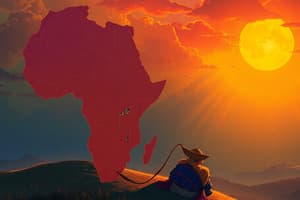Podcast
Questions and Answers
Which physiographic region in Africa is characterized by acacia trees, rolling hills, and wildlife?
Which physiographic region in Africa is characterized by acacia trees, rolling hills, and wildlife?
- The Sahara desert
- Savannas (correct)
- Mountain ranges
- Rift Valley lakes
Which mountain chain in Africa includes Mount Kilimanjaro and Atlas Mountains, creating stunning visual backdrops and supporting unique biomes?
Which mountain chain in Africa includes Mount Kilimanjaro and Atlas Mountains, creating stunning visual backdrops and supporting unique biomes?
- Savannas
- Congo Basin rainforest
- Mountain ranges (correct)
- Rift Valley lakes
Which of the following is NOT a major landform in Africa according to the text?
Which of the following is NOT a major landform in Africa according to the text?
- Savannas
- Congo Basin rainforest (correct)
- The Sahara desert
- Rift Valley lakes
Which of the following habitats were formed during tectonic processes along the Great Rift Valley in Africa?
Which of the following habitats were formed during tectonic processes along the Great Rift Valley in Africa?
Which region of Africa offers refuge to endemic plant and animal species due to being one of the world's largest tropical forests?
Which region of Africa offers refuge to endemic plant and animal species due to being one of the world's largest tropical forests?
What is the significance of coastal plains in Africa?
What is the significance of coastal plains in Africa?
Which of the following is true about Africa's bird species?
Which of the following is true about Africa's bird species?
What is the primary focus of commercial farming in Africa?
What is the primary focus of commercial farming in Africa?
What is a key challenge faced by modern agriculture in Africa?
What is a key challenge faced by modern agriculture in Africa?
Why do domestic animals play a significant role in Africa?
Why do domestic animals play a significant role in Africa?
Flashcards are hidden until you start studying
Study Notes
Land and Resources of Africa: Major Landforms, Biodiversity, and Agriculture
Africa is a continent marked by vast landscapes, diverse ecosystems, and abundant natural resources, shaping its geography, environment, and economy. To understand this dynamic region better, let's explore three key aspects – major landforms, biodiversity, and agricultural practices.
Major Landforms
Geographically, Africa can be divided into six distinct physiographic regions according to their topographical features:
- The Sahara: A desert covering approximately one-third of the African continent, it encompasses sand dunes, rocky plateaus, and oases.
- Savannas: This expansive grassland stretches across West, East, Central, and Southern Africa, characterized by acacia trees, rolling hills, and wildlife.
- Mountain ranges: Prominent mountain chains like Mount Kilimanjaro (Tanzania), Mount Kenya, Cameroon Line (Cameroon and Nigeria) and Atlas Mountains (North Africa) create stunning visual backdrops while also supporting unique biomes.
- Rift Valley lakes: Famous for Lake Victoria, Lake Tanganyika, and Lake Malawi, these bodies of water were formed during tectonic processes along the Great Rift Valley, providing habitats for various flora and fauna species.
- Congo Basin rainforest: One of the world's largest tropical forests spans through several countries, including DR Congo, Cameroon, and Gabon, offering refuge to endemic plant and animal species.
- Coastal plains: Extensive coastal regions, such as those found in South Africa and Egypt, serve as delicate ecological systems between terrestrial habitats and oceanic environments.
Biodiversity
With over two million documented plant and animal species, Africa hosts some of the richest and most varied biological wealth globally. Some notable highlights include:
- Mammals: Elephants, cheetahs, baboons, okapis, and chimpanzees are just a few examples of the iconic mammalian diversity on the continent.
- Birds: Over 2,200 bird species reside within the boundaries of Africa, making it home to more avifaunae than any other continent except South America.
- Reptiles: Numerous venomous snake species thrive here alongside vibrantly colored chameleons and monitor lizards.
- Fish: Lake Tanganyika alone boasts nearly 250 fish species, many of which live nowhere else on Earth.
- Amphibians and insects: The majority of frogs, toads, and other amphibian species, plus millions of unique insect varieties, call Africa home.
Agriculture
Despite facing challenges such as limited arable land, poor soil quality, and frequent climate change events, modern farming techniques continue to improve food production levels throughout the continent:
- Subsistence farming: Smallholder farmers cultivate staple crops, such as maize, sorghum, millet, rice, cassava, sweet potatoes, yams, and vegetables, with varying degrees of success depending on local climates, soils, and availability of irrigation systems.
- Livestock rearing: Domestic animals play a significant role in Africa; they help subsidize family income from meat, milk, and hide sales, contribute to labor intensive tasks, and act as a form of currency when not needed.
- Commercial farming: Large scale farms focus on cash crop export, primarily sugarcane, tobacco, cotton, coffee, tea, fruits, and oilseeds.
- Agroecology: Farmers across the continent increasingly adopt agroecological approaches to enhance productivity and environmental sustainability.
In conclusion, understanding the interplay among landform types, biodiversity, and agricultural practices in Africa provides insights into both the challenges faced by Africans and the potential opportunities available for sustainable development.
Studying That Suits You
Use AI to generate personalized quizzes and flashcards to suit your learning preferences.






